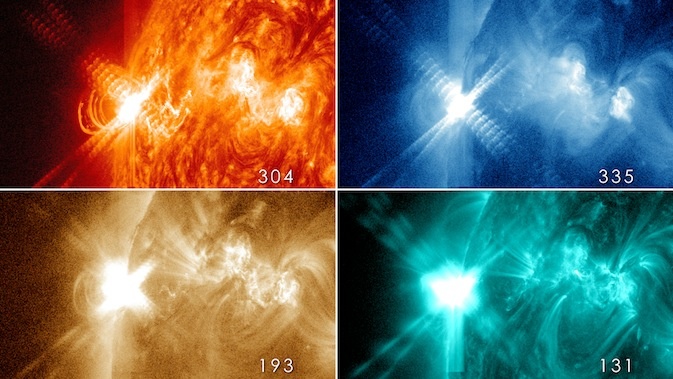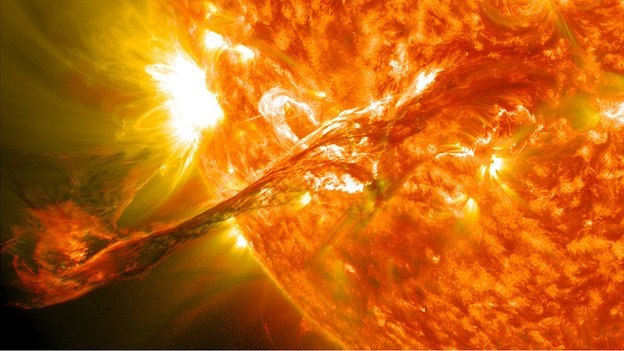
These pictures from NASA’s Solar Dynamics Observatory show the three X-class flares that the sun emitted
These pictures from NASA’s Solar Dynamics Observatory show the three X-class flares that the sun emitted in under 24 hours on May 12-13, 2013. The images show light with a wavelength of 131 angstroms, which is particularly good for showing solar flares and is typically colorized in teal. View a larger image here
When these eruptions reach Earth, they can interfere with electronic systems in satellites and those on the ground.
Solar flares are powerful bursts of radiation. Harmful radiation from a flare cannot pass through Earth’s atmosphere to physically affect humans on the ground, however — when intense enough — they can disturb the atmosphere in the layer where GPS and communications signals travel. This disrupts the radio signals for as long as the flare is ongoing – the radio blackout associated with this flare has since subsided.

Four images from NASA’s Solar Dynamics Observatory of an X3.2-class flare from late at night on May 13, 2013. Starting in the upper left and going clockwise, the images show light in the 304-, 335-, 193- and 131-angstrom wavelengths. By looking at the sun in different wavelengths, scientists can view solar material at different temperatures, and thus learn more about what causes flares.
The Impacts of Solar Flares
Some people worry that a gigantic “killer solar flare” could hurl enough energy to destroy Earth, but this is not actually possible. Read more
“X-class” denotes the most intense flares, while the number provides more information about its strength. An X2 is twice as intense as an X1, an X3 is three times as intense, etc.
This flare erupted from an active region just out of sight over the left side of the sun, a region that will soon rotate into view. This region has produced two smaller M-class flares as well.

On May 12, 2013, the sun emitted a significant solar flare, peaking at 10 p.m. EDT. This flare is classified as an X1.7, making it the first X-class flare of 2013. The flare was also associated with another solar phenomenon, called a coronal mass ejection (CME) that can send solar material out into space. This CME was not Earth-directed.
The May 12 flare was also associated with a coronal mass ejection, another solar phenomenon that can send billions of tons of solar particles into space, which can affect electronic systems in satellites and on the ground. Experimental NASA research models show that the CME left the sun at 745 miles per second and is not Earth-directed, however its flank may pass by the STEREO-B and Spitzer spacecraft, and their mission operators have been notified. If warranted, operators can put spacecraft into safe mode to protect the instruments from solar material. There is some particle radiation associated with this event, which is what can concern operators of interplanetary spacecraft since the particles can trip computer electronics on board.

A Solar Flare streaks out from the Sun
